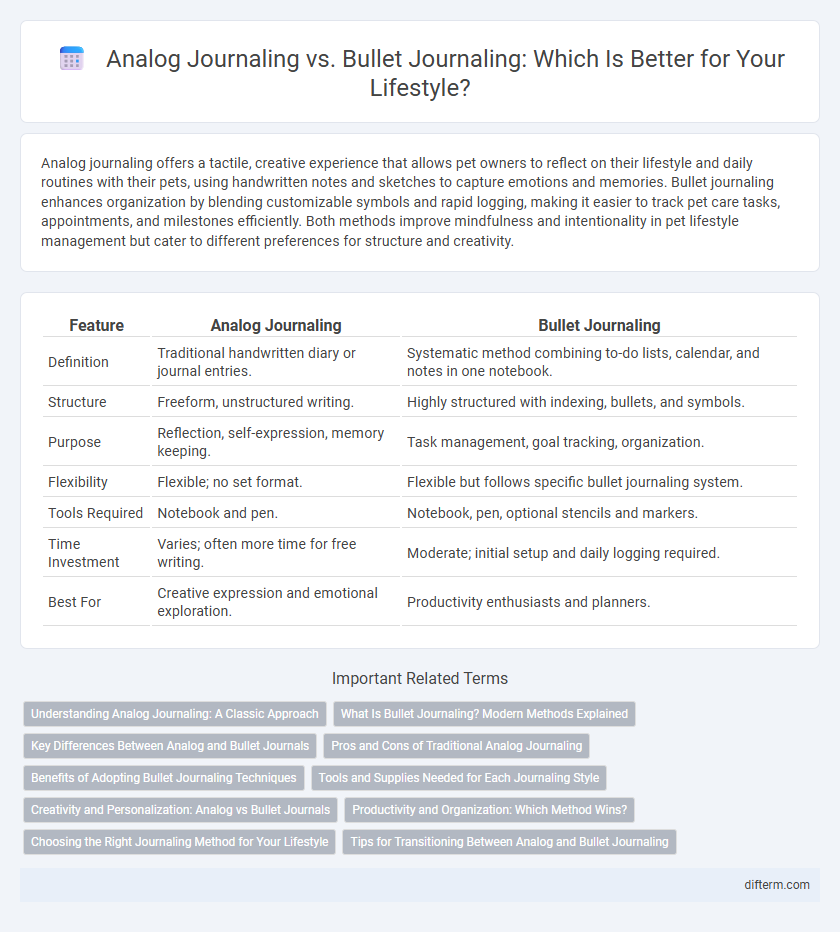Analog journaling offers a tactile, creative experience that allows pet owners to reflect on their lifestyle and daily routines with their pets, using handwritten notes and sketches to capture emotions and memories. Bullet journaling enhances organization by blending customizable symbols and rapid logging, making it easier to track pet care tasks, appointments, and milestones efficiently. Both methods improve mindfulness and intentionality in pet lifestyle management but cater to different preferences for structure and creativity.
Table of Comparison
| Feature | Analog Journaling | Bullet Journaling |
|---|---|---|
| Definition | Traditional handwritten diary or journal entries. | Systematic method combining to-do lists, calendar, and notes in one notebook. |
| Structure | Freeform, unstructured writing. | Highly structured with indexing, bullets, and symbols. |
| Purpose | Reflection, self-expression, memory keeping. | Task management, goal tracking, organization. |
| Flexibility | Flexible; no set format. | Flexible but follows specific bullet journaling system. |
| Tools Required | Notebook and pen. | Notebook, pen, optional stencils and markers. |
| Time Investment | Varies; often more time for free writing. | Moderate; initial setup and daily logging required. |
| Best For | Creative expression and emotional exploration. | Productivity enthusiasts and planners. |
Understanding Analog Journaling: A Classic Approach
Analog journaling offers a tactile and immersive experience that fosters deeper reflection through handwritten entries, allowing individuals to connect emotionally with their thoughts and memories. This classic approach emphasizes the use of notebooks, pens, and physical materials, promoting mindfulness and reducing digital distractions common in bullet journaling apps. By prioritizing simplicity and personalization, analog journaling supports creativity and mental clarity, making it an enduring method for daily organization and self-expression.
What Is Bullet Journaling? Modern Methods Explained
Bullet journaling is a customizable analog organization system that combines elements of a diary, planner, and to-do list, designed to enhance productivity and mindfulness. It uses rapid logging with symbols like bullets, dashes, and circles to categorize tasks, events, and notes, allowing users to track goals and habits visually. Modern bullet journaling incorporates minimalist design and digital templates, making it adaptable for both creative expression and efficient time management.
Key Differences Between Analog and Bullet Journals
Analog journaling emphasizes freeform writing and creativity with minimal structure, allowing personal expression through varied handwriting and art. Bullet journaling uses a systematic framework of symbols, rapid logging, and indexed organization to track tasks, events, and notes efficiently. Key differences lie in analog journaling's open-ended format compared to bullet journaling's goal-oriented, customizable modular system.
Pros and Cons of Traditional Analog Journaling
Traditional analog journaling offers a tactile experience that enhances creativity and memory retention through handwriting, providing a personal and unrestricted space for expression. It promotes mindfulness and reduces digital distractions but may lack the organizational efficiency and flexibility found in bullet journaling systems. Physical journals can be less portable and harder to edit, requiring more effort to categorize and track tasks compared to digital or bullet journal formats.
Benefits of Adopting Bullet Journaling Techniques
Bullet journaling enhances organization by combining task management, goal tracking, and creative expression within a customizable framework tailored to individual needs. It promotes mindfulness and productivity through rapid logging, prioritization, and habit tracking features, fostering improved focus and time management. Unlike traditional analog journaling, bullet journaling offers flexibility and efficiency, making it a powerful tool for personal and professional growth.
Tools and Supplies Needed for Each Journaling Style
Analog journaling requires basic tools such as a quality notebook, pens, pencils, and sometimes colored markers or stickers to personalize entries. Bullet journaling involves a dotted or grid notebook, fine-tip pens, rulers for creating layouts, and often stencils or washi tapes to enhance organization and design. Both styles benefit from using archival-quality paper and ergonomic writing instruments to ensure durability and comfort during extended writing sessions.
Creativity and Personalization: Analog vs Bullet Journals
Analog journaling fosters creativity through unrestricted freedom in design, allowing for personalized handwriting, doodles, and mixed media integration that reflect individual artistic expression. Bullet journaling enhances organization while offering customizable templates like rapid logging and symbols, enabling users to efficiently tailor layouts to their lifestyle needs and preferences. Both methods encourage personalization, with analog journals emphasizing artistic creativity and bullet journals focusing on systematic, flexible structure.
Productivity and Organization: Which Method Wins?
Analog journaling enhances productivity through tactile engagement and personalized layouts, promoting mindfulness and deeper focus on tasks. Bullet journaling offers a structured, modular system with rapid logging techniques that streamline organization and prioritize task management efficiently. Choosing between the two depends on whether preference leans toward creative flexibility or systematic productivity optimization.
Choosing the Right Journaling Method for Your Lifestyle
Choosing the right journaling method depends on your lifestyle and personal goals, with analog journaling offering a tactile, creative experience ideal for those who value reflection and mindfulness. Bullet journaling provides a customizable, structured approach suited for individuals seeking productivity, organization, and goal tracking. Consider how each method aligns with your daily routine, time availability, and mental clarity needs to enhance your journaling practice effectively.
Tips for Transitioning Between Analog and Bullet Journaling
When transitioning from analog journaling to bullet journaling, start by gradually incorporating key bullet journal elements such as rapid logging, signifiers, and customizable modules into your existing analog system. Prioritize using a minimalist notebook and fine-tip pens to enhance organization and clarity, ensuring flexibility to adapt layouts based on personal productivity needs. Regularly review your bullet journal's indexing and future log to maintain seamless tracking and goal setting during the transition.
Analog journaling vs Bullet journaling Infographic

 difterm.com
difterm.com